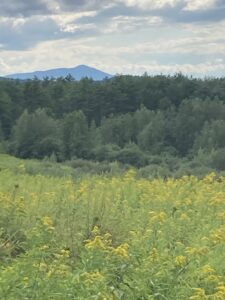 The Hanover Conservancy is preparing to protect one of our town’s most cherished historic agricultural landscapes. The Adams Farm, which offers a rare and spectacular view of Mount Ascutney from Trescott Road, is listed in Hanover’s Scenic Locales Report and has long been a key conservation priority for both the Conservancy and the Town. The new landowners wish to revitalize agriculture on this prime farmland.
The Hanover Conservancy is preparing to protect one of our town’s most cherished historic agricultural landscapes. The Adams Farm, which offers a rare and spectacular view of Mount Ascutney from Trescott Road, is listed in Hanover’s Scenic Locales Report and has long been a key conservation priority for both the Conservancy and the Town. The new landowners wish to revitalize agriculture on this prime farmland.
This parcel has no access to town water or sewer. The permanent easement will focus on the farm’s best soils and ecologically valuable land, which includes the beloved view of Mt. Ascutney. The new owners have a deep appreciation for the rural farming history of Hanover and are determined to bring it back to life on this property with its prime soils.
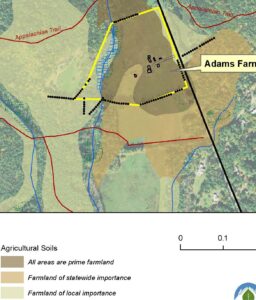 Farming: Prime agricultural soils, not commonly found in Hanover except in already-developed areas, are present on 98% of the area proposed for protection. The 23-acre property, which once included the Hudson Farm and land across Trescott Road, is all that remains of a major sprawling farm. Over the years sheep and later cattle grazed here, and former owner Bob Adams raised oxen. It was he who helped start the Hanover Center Old Timers’ Fair and its favorite attraction (beside the pies), the oxen pull. One of the farm’s sheds still houses a collection of yokes.
Farming: Prime agricultural soils, not commonly found in Hanover except in already-developed areas, are present on 98% of the area proposed for protection. The 23-acre property, which once included the Hudson Farm and land across Trescott Road, is all that remains of a major sprawling farm. Over the years sheep and later cattle grazed here, and former owner Bob Adams raised oxen. It was he who helped start the Hanover Center Old Timers’ Fair and its favorite attraction (beside the pies), the oxen pull. One of the farm’s sheds still houses a collection of yokes.
The new owners are sharpening their vision of how the now-fallow land can become vibrant farmland once again. They look forward to protecting the wetland, rejuvenating the structures and fields, and returning agrarian activity to the property. Farming activity here would complement the nearby Mink Meadow Farm, providing another user of farm-related equipment and services where dwindling need for these providers is becoming a hardship.
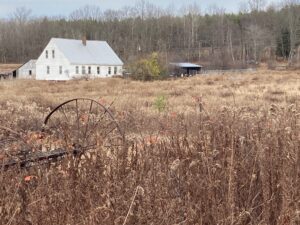 An Historic Landscape: The Adams Farm is one of the most visible examples of the iconic rural agricultural landscape in Hanover, with its gently rolling meadows, stone walls, and early homestead. The late 18th century farmhouse may have been a tavern on what was once a well-traveled road leading from the south. Traces of this old road are still visible in LiDAR imagery of the land. It was later re-routed onto the Hudson Farm and is known as Old Highway 38, a favorite footpath linking to the nearby Appalachian Trail.
An Historic Landscape: The Adams Farm is one of the most visible examples of the iconic rural agricultural landscape in Hanover, with its gently rolling meadows, stone walls, and early homestead. The late 18th century farmhouse may have been a tavern on what was once a well-traveled road leading from the south. Traces of this old road are still visible in LiDAR imagery of the land. It was later re-routed onto the Hudson Farm and is known as Old Highway 38, a favorite footpath linking to the nearby Appalachian Trail.
The new owners had originally hoped to restore the historic farmstead and make it their family’s home. They discovered, however, that a mid-19th century remodeling of the house had severely damaged its timber frame, making the home unsafe to occupy without complete rebuilding. They chose instead to build a new home back from the road on less valuable soils, to avoid compromising the view of the land.
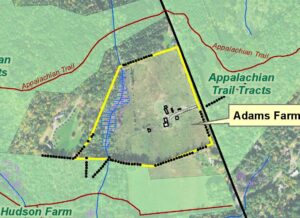 Climate Change Resilience: Protecting the Adams Farm from development reflects the Hanover Conservancy’s strategic goals for the rural region of town. This farm is currently surrounded by well-protected tracts of the Appalachian Trail and the recently-conserved Mink Brook Community Forest. The easement will result in important habitat connections and ecological diversity within this large block (nearly 1,100 acres, shown in green on map) of protected forests, wetlands, and meadows in the otherwise developed part of town between Etna, Trescott, and Greensboro Roads. Federal, state, municipal, and Conservancy efforts have combined in recent years to achieve this remarkable conservation success. Protecting the Adams Farm is the key next step.
Climate Change Resilience: Protecting the Adams Farm from development reflects the Hanover Conservancy’s strategic goals for the rural region of town. This farm is currently surrounded by well-protected tracts of the Appalachian Trail and the recently-conserved Mink Brook Community Forest. The easement will result in important habitat connections and ecological diversity within this large block (nearly 1,100 acres, shown in green on map) of protected forests, wetlands, and meadows in the otherwise developed part of town between Etna, Trescott, and Greensboro Roads. Federal, state, municipal, and Conservancy efforts have combined in recent years to achieve this remarkable conservation success. Protecting the Adams Farm is the key next step.
Sudden severe storms related to climate change have caused widespread and expensive damage in recent years, adding new urgency to protecting the natural hydrology of the Mink Brook watershed. The farm’s wetland guards against flooding and water pollution in the nearby village of Etna and in lower Mink Brook, Hanover’s largest stream, as it flows through settled neighborhoods, the Mink Brook Community Forest, and the Mink Brook Nature Preserve.
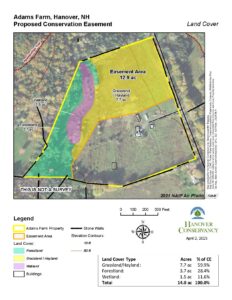 A Permanent Conservation Easement: The Hanover Conservancy is working with the USDA Natural Resources Conservation Service to permanently protect the majority of this historic rural farmscape with an agricultural land easement. NRCS has committed to funding 50% of the fair market value of the easement. A grant from the Appalachian Trail Conservancy’s Wild East Action Fund is helping to cover some transaction expenses. Because public trails already surround the property, public access won’t be required on the easement area, although the landowners are free to allow it.
A Permanent Conservation Easement: The Hanover Conservancy is working with the USDA Natural Resources Conservation Service to permanently protect the majority of this historic rural farmscape with an agricultural land easement. NRCS has committed to funding 50% of the fair market value of the easement. A grant from the Appalachian Trail Conservancy’s Wild East Action Fund is helping to cover some transaction expenses. Because public trails already surround the property, public access won’t be required on the easement area, although the landowners are free to allow it.
The Conservancy must raise $250,000 to match the NRCS grant for easement acquisition and for long-term stewardship.
The Hanover Conservation Commission has stepped up, voting to support this project with a challenge grant of $25,000 from the Town’s Conservation Fund, to be matched by local contributions.
The help of Conservancy friends and Etna neighbors is essential to reaching this goal. A generous neighbor has pledged $25,000 to show the way, and an anonymous donor has pledged $10,000 if other costs can be raised. All contributions are tax-deductible and count toward the Conservancy’s $2 million Promise to Protect capital campaign. DONATE
The Conservancy will assume responsibility for monitoring the easement in perpetuity.




